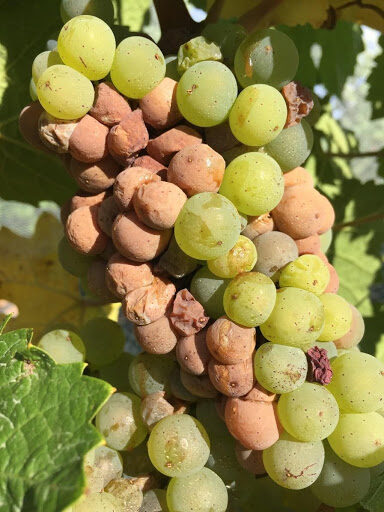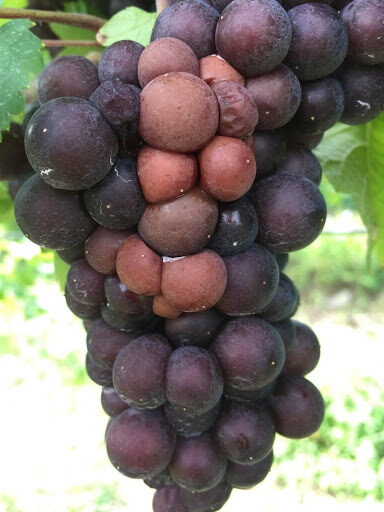Research Highlight: Grape Sour Rot – A complex disease and a problem in Viticulture for the whole East Coast.
Interview with Megan Hall, Assistant Professor at the University of Missouri and leading specialist on Sour Rot.
Tekan Rana (MHS Student), Small Fruits Research and Extension Group, Department of Horticulture Science, NC State University
Mark Hoffmann, Small Fruits Extension Specialist, Department of Horticulture Science, NC State University
Introduction:
Sour rot is a disease complex caused by multiple factors. It is more prevalent in the cultivars with aromatic ripening, thin skin or tight clusters. While sour rot was confused with Botrytis bunch rot in the past, today it is clear the Sour Rot is a complex disease, including fungal, bacterial organisms and insects. Symptoms of sour rot is a typical vinegar smell in the vineyard, berries with wet rot, browning fruit with oozing berries. Symptoms appears in both red and white cultivars (Fig. 1-2). Sour rot is a major problem, especially at the East Coast, where climate conditions are more conductive to the disease. Due to it’s complexity, sour-rot is not easy to manage. Here we ask one of the leading experts on Sour Rot in the US, Dr. Megan Hall from the University of Missouri, about management, challenges and future prospects of Sour-rot management in the US.




Importance of Sour rot:
Besides making affected fruit unmarketable for fresh market, sour rot also negatively affects the wine quality. The wine from the sour rotted fruits has a sharp acetic acid taste, and the potential for high volatile acidity (VA). It also creates possibility for strong nail polish odor that can reduce the sensory quality of the wine. Besides reducing wine quality and fruit marketability, sour rot increases the cost of production. For instance, fruit from moderately infected vineyards (<60%) will increase the cost during the wine making process and add cost for e.g. reverse osmosis (RO) treatment (to minimize the ethyl acetate concentration) or the selection of a suitable yeast strain that can survive in higher acetic acid concentration. Moreover, pesticide applications and other vineyard management methods to control disease also increase the financial burden to the grower. Sour-rot in the Southeast can become can become quickly a very severe problem, and vineyard managers often need to make harvest decisions, even when grape are not at the optimal quality. This is especially try for thin-skinned cultivars such as Riesling, Pinots, and others.
Management Challenges of Sour Rot:
Despite the huge risk on the grape and wine industry caused by sour rot, the disease was widely a mystery to science until recently. Dr. Hall is studying sour rot now for more than seven years, and achieved a PhD working on sour rot with Wayne Wilcox in New York. “Sour rot is not a ‘typical’ disease in the sense that it is not caused by one or multiple plant pathogens”. According to Dr. Hall, sour rot rather is caused by a combination of yeast and acetic acid bacteria (normally not considered as pathogen), fruit flies (Drosophila), and a physical wound on the fruit. Dr. Hall’s study found that the yeast or bacteria found in or on the healthy berry cannot develop sour rot themselves. One of the most important factors is a physical wound one the fruit as entry point of yeasts, bacteria and insects. This wound can be caused by birds, insects, rain, hail or other fungal infections. In a healthy berry, yeast ferments sugar into ethanol, and bacteria convert the ethanol into the acetic acid. Aerobic conditions of a wounded fruit promotes the growth of different bacteria and yeasts. This will attract fruit flies to lay eggs, and after hatching of those larvae, berry pulp will be liquefied and producing a vinegar-like smell in the vineyard. The damage can explode in a matter of a few days from a few berries to the majority of clusters in a certain vineyard block.
“Sour rot is important to industries worldwide because it causes significant damage in a short amount of time, and because there isn’t a single culprit.”
Sour rot management is challenging. “It’s important to industries worldwide because it causes significant damage in a short amount of time, and because there isn’t a single culprit. Trying to control microbes that are both ubiquitous and non-pathogenic is a challenge, as is controlling fruit flies. The responsible organisms are anything but rare, but they come together in a perfect storm to cause these symptoms that can be devastating to growers and winemakers”, Dr. Hall says. The complex nature of disease and wet condition around harvest time in East Coast add the risk of the sour rot damage on the grape growers of the region.
Recommendations for grape growers on sour rot management:
There is no silver bullet for the sour rot control, especially once it starts in the vineyard. It is best to take preventive measures to control the disease, rather than to wait until it is too late. “Any measures that can be employed to protect fruit from damage and allow airflow in the canopy are going to be of utmost importance,” Dr. Hall says. “The best thing a grower can do is to know which blocks and varieties in their vineyard are most susceptible, and begin treating before the symptoms begin to develop, usually right before sugars get to 14-15 Brix.” Moreover, she added that timing of the treatment of sour rot is determined by the damage and population of the fruit fly— if higher population levels are observed, earlier treatments might be required.
”The best thing a grower can do is to know which blocks and varieties in their vineyard are most susceptible, and begin treating before the symptoms begin to develop, usually right before sugars get to 14-15 Brix”
Now the question is what should we use to control even as preventive measures? Based on a 2013-2016 study in Geneva, Dr. Hall recommends the combination of Mustang Maxx (zeta-cypermethrin) and Oxidate 2.0 (peroxyacetic acid) in weekly interval to control both insects and microbes. “Spray applications have to begin before symptoms develop in order to have the best effect or else the disease has already established, and it is very difficult (if not impossible) to control the generations of fruit flies that will continue to emerge from the grapes.” Dr. Hall says. Early monitoring of fruit fly populations in those vineyard blocks that are most susceptible for Sour Rot is therefore necessary, especially of heavy rain fall or hail have caused damage to berries and clusters.
While recommending those chemical measures, she also cautions growers to minimize the use of chemicals if not necessary. Several species of the fruit fly (Drosophila) can develop insecticide resistance and used chemicals would not be effective anymore. Thus, currently she is working with her graduate student, Patrick Kenney, to target specific growth stages of the fruit fly and minimize the chemical spray. Regarding her future study Dr. Hall says, “My main priority is to develop improved spray guidelines that will involve better timed, more targeted sprays.”
To summarize, sour rot is a major challenge to grape growers world wide, and especially at the East Coast of the US. While every cultivar can be affected by sour-rot, it is often the think-skinned cultivars that regularly experience large sour rot outbreaks in the Southeast. Preventative measures, starting at early Brix levels, and consistent early monitoring are the key management strategies for sour rot in the US.
Additional sources:
https://content.ces.ncsu.edu/north-carolina-winegrape-growers-guide/chapter-8-pest-management
http://ipm.ucanr.edu/PMG/r302100211.html
https://pnwhandbooks.org/node/2787/print
https://extension.psu.edu/managing-sour-rotted-fruit-in-the-cellar
https://www.canr.msu.edu/news/management_of_bunch_rot_diseases_in_grapes
This interview was conducted by Tekan Rana.